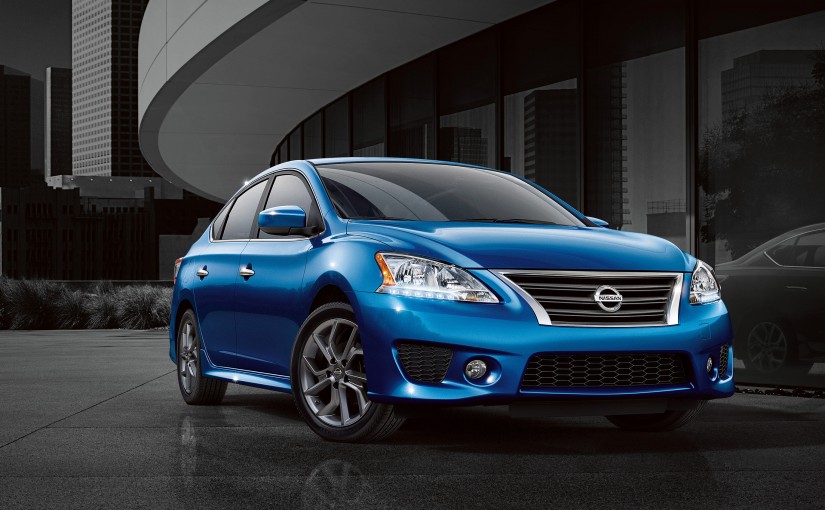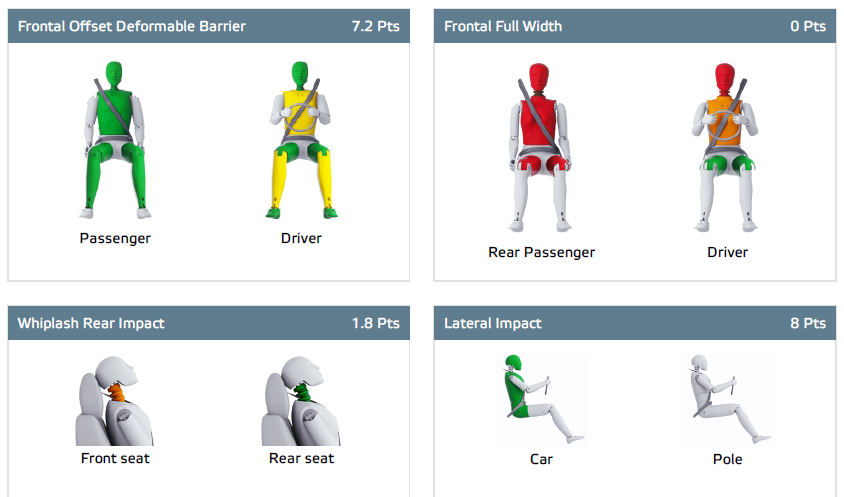With those criteria, this is the vehicle we decided to purchase.
Safety
There are three safety ratings boards to pay attention to. The Insurance Institute for Highway Safety (IIHS), the National Highway Traffic Safety Administration (NHTSA) and The European New Car Assessment Programme (Euro NCAP).
Check out your own vehicle at the links above–I’d lean toward the IIHS over the NHTSA for the reasons outlined in this article.
The Euro NCAP post really detailed crash info on the vehicles they test, which is a nice cross reference if they’ve tested the vehicle you’re interested in. Just be aware of any regional differences–some European models feature side air-bags, while the NA version might not, etc. The results should not be considered directly comparable to what the IIHS or NHTSA report.
I wish the IIHS would adopt this model. When I first researched the Honda Fit about a decade ago I was shocked to learn a vehicle can score a 5-star safety rating, even if you were likely to lose all your limbs in a crash. It seems limbs are considered expendable, and don’t factor into the overall rating. I happen to think that’s absurd, and I imagine other people would too if they had any idea that was the case.
Here’s the IIHS page for the Nissan Sentra 2015
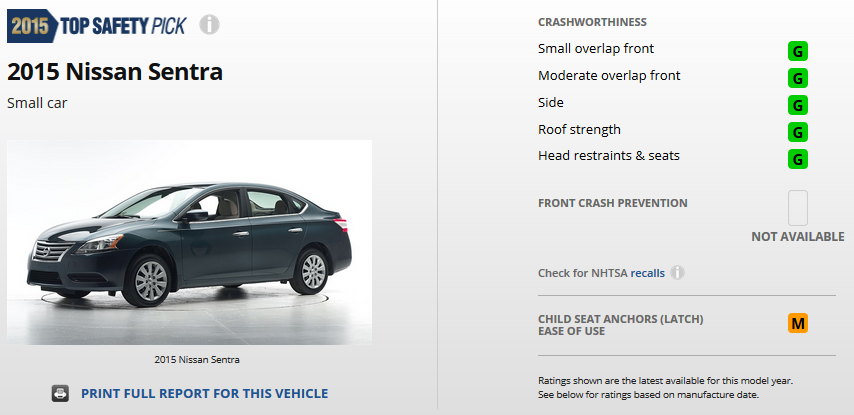 Pay attention to the small overlap test, as this is the most demanding, and arguably the most important test.
Pay attention to the small overlap test, as this is the most demanding, and arguably the most important test.
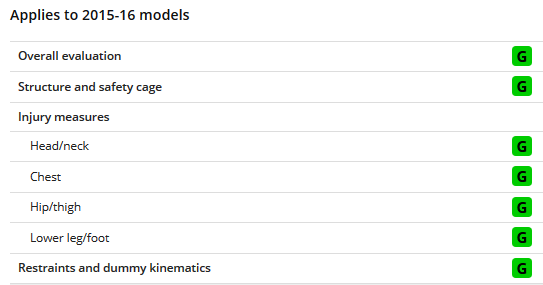 So when you slam the vehicle into various barriers, it performs very well. Let’s dig a little further. This is an absolutely amazing chart.
So when you slam the vehicle into various barriers, it performs very well. Let’s dig a little further. This is an absolutely amazing chart.
 It breaks down–adjusting for distortions–the likelihood of crashes or injury in relative terms to other vehicles in the same class. You can see here that the Sentra doesn’t fare very well–having elevated stats in the injury column. How does this make any sense based on the above testing, by the same institute?
It breaks down–adjusting for distortions–the likelihood of crashes or injury in relative terms to other vehicles in the same class. You can see here that the Sentra doesn’t fare very well–having elevated stats in the injury column. How does this make any sense based on the above testing, by the same institute?
I’m guessing the stats are distorted by the inclusion of data all the way back to 2012–where the Sentra failed the small offset crash miserably.
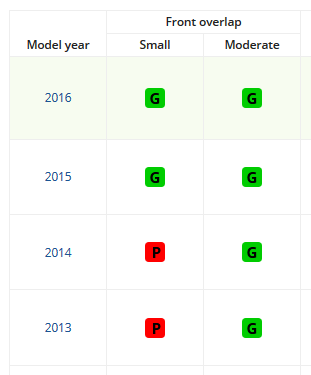 In fact it wasn’t until 2014 that the Sentra started making progress
In fact it wasn’t until 2014 that the Sentra started making progress
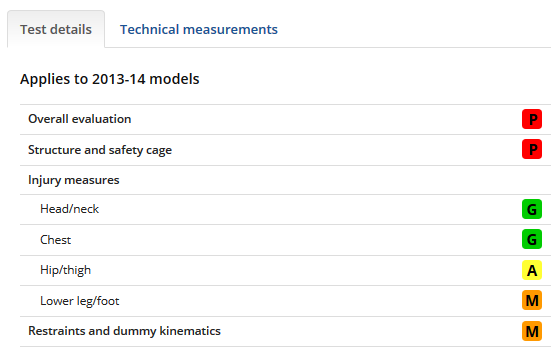 The 2015 model was adjusted even further to strengthen the doors, resulting in a rating of “good” across the board. Now after an accident you stand a better chance of walking away–partly because you’ll still have your lower legs and feet.
The 2015 model was adjusted even further to strengthen the doors, resulting in a rating of “good” across the board. Now after an accident you stand a better chance of walking away–partly because you’ll still have your lower legs and feet.
So IMHO the average is being pulled down by the inclusion of 2012 and 2013 and the injuries inherit to failing the small offset test–the most likely type of injury collision you can be involved in. The stats don’t yet include 2015, and the data from 2014 will still contribute to claims for mangled hips/thighs, legs and feet (nothing like practical car-shopping!).
I’m confident the injury stats will come down for the 2015 year, reflecting the structural changes and subsequently glowing safety test results.
Injuries aside, the crash stats are higher for the Nissan as well, but I suspect driver distraction is to blame. Vehicles that had fewer collisions tended to be a) very small and b) sporty; and in some cases incredibly expensive. Small cars don’t house children very well–the mother of all distractions. I believe the vehicle to be safe–something about the way it is being driven is contributing to the elevated risk of collision. I’m a mono-tasker when I drive so I’m comfortable with the stats. Moving on.
Price
We set a limit of $20,000 after tax. This was far higher than I was comfortable with, but I guess reality has to set in at some point; you can’t ride your bike everywhere in Canada. That left us with a shortlist of two vehicles; the Nissan Sentra and Mazda 3 Sport.
Must Haves
We really wanted power doors and locks, cruise control, and air conditioning. Due to my mis-reading of a sales brochure, we thought the base model Mazda 3 Sport included these options. It does not, and it was eventually eliminated from consideration anyway. The Sentra includes power and cruise control in its base, and if you opt for the CVT engine you get air.
The Test Drive
We checked dealerrater.ca and chose which dealerships to try based on their reviews. I’d say our experiences were very much in line with what had been previously reported.
Neither of us where particularly thrilled by the Mazda 3 Sport. My partner found the headrest uncomfortable, and the vehicle generally cramped. A stroller eats up the entirely of the hatchback, and a rear-facing car-seat not only pushes the front passenger seat too far forward, but creates a blind-spot entirely obscuring the rear window. That combined with the long-standing (1996-present) rust issues inherent to Mazda left us pretty sour on it.
Our test drive of the Sentra was the exact opposite experience. It was roomy and comfortable, though the rear seats of the Mazda were admittedly better. We both preferred the styling of the Sentra–I guess we’re getting old, LOL.
Neither vehicle has a lot of guts, but you can pass on the highway, and fast acceleration generally means you’re burning lots of fuel anyway, so “meh”. The Sentra includes a feel-good ECO mode that apparently rewards you with leaves or charms or some such incentive not to hammer on the gas. I’m curious to give it a try.
The Deal
We’d run some numbers through Car Cost Canada and came up with an amount we were prepared to pay, allowing for a low but reasonable dealer profit.
Long story short, we ended up getting the vehicle at just over their cost. We lucked out in that our wish list perfectly matched the specific model that was featured in one of their advertisements (the one they always up-sell from), whose sale is strictly governed by provincial law. All they can add is tax, and we qualified for a number of dealer-side rebates due to prior ownership and cash financing.
Nissan Sentra 2015 FTW.
A sleek looking (to us at least) roomy family vehicle with the features we wanted, at a great price. Feeling good.
Update: Have been driving the vehicle for a bit now–damn do new cars stink!
